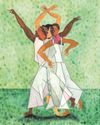
In 1941, when Preston Sturges, the master of the screwball comedy, won the first Academy Award for Best Original Screenplay, he stumbled onstage and attempted a joke. Sturges, who won for “The Great McGinty”—a satire about a poor man, in an unnamed American city, who fails upward until he becomes governor—wasn’t fond of institutions and their puffed-up accolades, and his speech, which ridiculed the ceremony, was particularly on brand. “Mr. Sturges was so overcome by the mere possibility of winning an Oscar,” he said, “that he was unable to come here tonight, and asked me to accept in his stead.” The room went quiet, Sturges recalled, and he slunk back to his table. His gag had bombed.
Or had it? In truth, everyone in the room likely knew who Sturges was. By the time he made “The Great McGinty,” he was one of the highest-paid men in Hollywood, pulling in ludicrous sums for a single screenplay. His contract with Paramount insured that he could direct his own scripts, minting him as one of cinema’s first major auteurs. In 1940, he had released two films (“McGinty” and “Christmas in July”), shot another (“The Lady Eve”), and opened the Players Club, a rowdy, two-story restaurant and night club on Sunset Boulevard, where he held court among industry nabobs. If Sturges’s speech was coolly received, it was not, as he suggested, because “nobody knew what I looked like.” The more probable reason is that, in a room packed with vain celebrities, nobody found it even slightly amusing that a person, when offered a moment of glory, might pretend to be someone else.
This story is from the {{IssueName}} edition of {{MagazineName}}.
Start your 7-day Magzter GOLD free trial to access thousands of curated premium stories, and 9,000+ magazines and newspapers.
Already a subscriber ? Sign In
This story is from the {{IssueName}} edition of {{MagazineName}}.
Start your 7-day Magzter GOLD free trial to access thousands of curated premium stories, and 9,000+ magazines and newspapers.
Already a subscriber? Sign In

ART OF STONE
\"The Brutalist.\"

MOMMA MIA
Audra McDonald triumphs in \"Gypsy\" on Broadway.

INTERNATIONAL AFFAIRS
\"Black Doves,\" on Netflix.

NATURE STUDIES
Kyle Abraham's “Dear Lord, Make Me Beautiful.”

WHAT GOOD IS MORALITY?
Ask not just where it came from but what it does for us

THE SPOTIFY SYNDROME
What is the world's largest music-streaming platform really costing us?

THE LEPER - LEE CHANGDONG
. . . to survive, to hang on, waiting for the new world to dawn, what can you do but become a leper nobody in the world would deign to touch? - From \"Windy Evening,\" by Kim Seong-dong.

YOU WON'T GET FREE OF IT
Alice Munro's partner sexually abused her daughter. The harm ran through the work and the family.

TALK SENSE
How much sway does our language have over our thinking?

TO THE DETECTIVE INVESTIGATING MY MURDER
Dear Detective, I'm not dead, but a lot of people can't stand me. What I mean is that breathing is not an activity they want me to keep doing. What I mean is, they want to knock me off. My days are numbered.